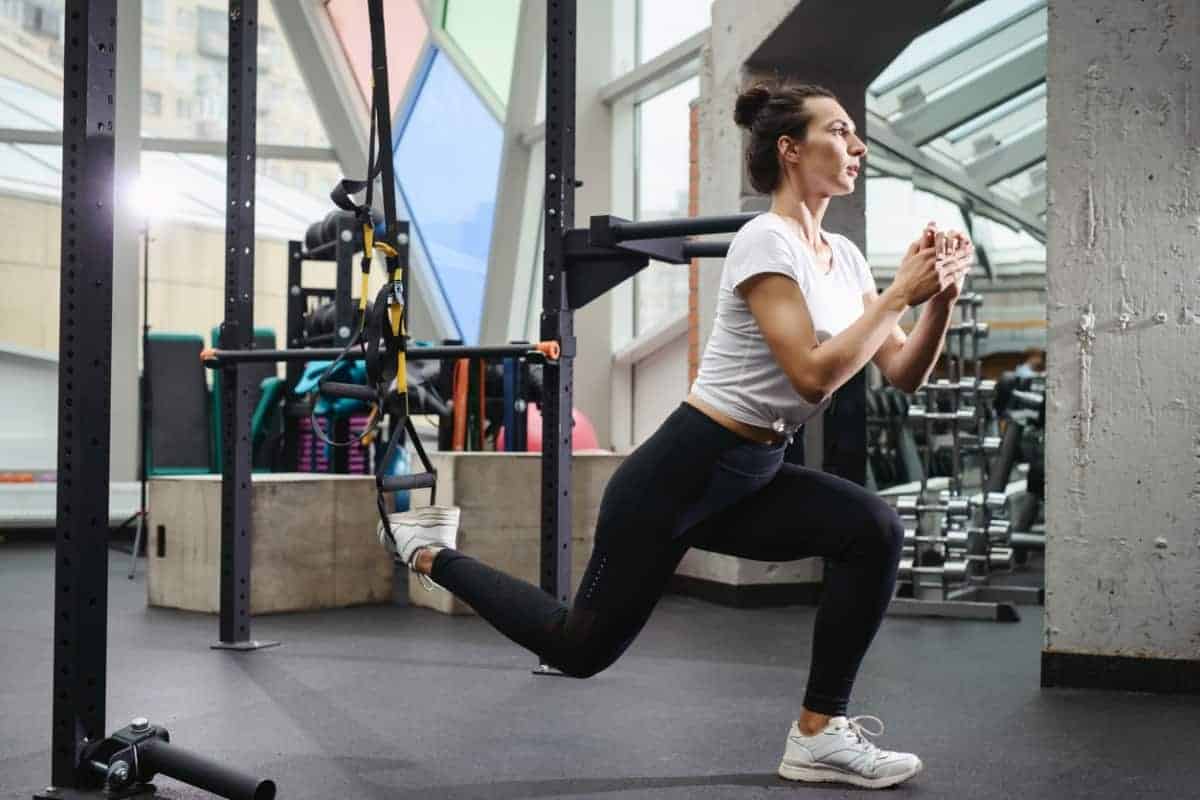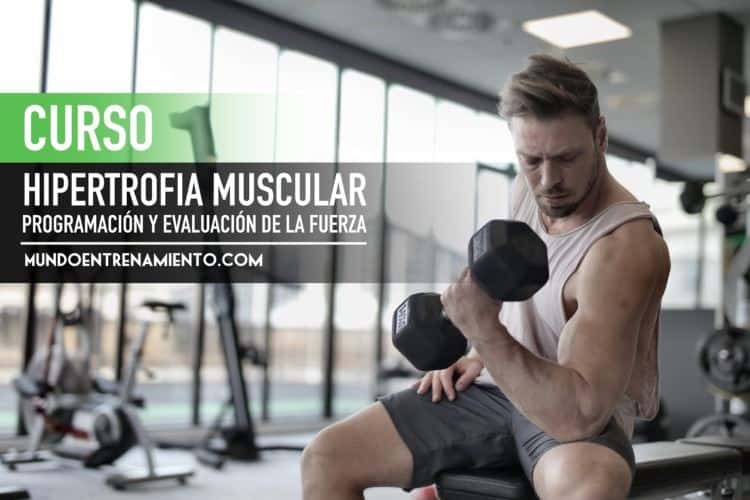In this article, we present a magnificent exercise to work the lower body muscles, the Bulgarian squat. We will see the particularities of the exercise and what differences it has with the classic squat.
What is the squat?
The classic squat is an exercise aimed at developing the lower body muscles.
In the execution of the squat, both knee and hip flexion and extension are performed, which involves a series of co-contractions of the involved muscles, causing a large part of the lower limb muscles to work simultaneously.
This is one of the reasons why the squat is one of the great exercises to include in our training programs.
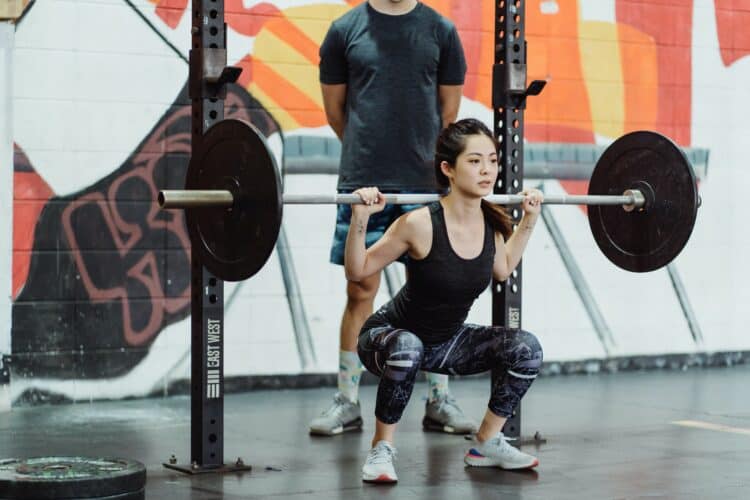
What is the Bulgarian squat?
The Bulgarian squat is an exercise mainly focused on working the hip and knee muscles. Additionally, it is a unilateral exercise, meaning that most of the work will be done on one leg, specifically the front one.
The fact that this exercise is unilateral will cause greater activation of the core muscles, helping to stabilize the structures involved in the movement.
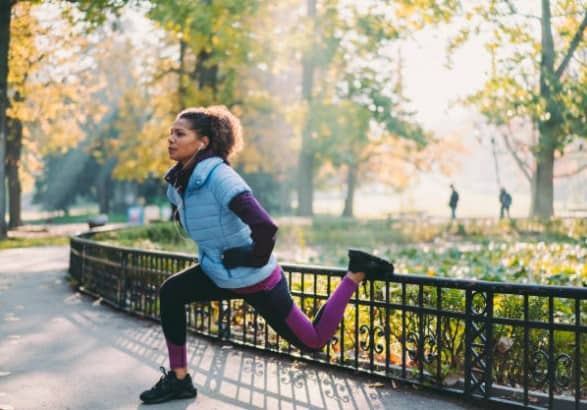
Benefits of the Bulgarian squat
This is a very complete exercise that provides many benefits, among which the following stand out:
- It is a global and multi-joint exercise that activates many muscles.
- Strengthens the activation of our core muscles.
- By strengthening the stabilizing muscles of the core, it reduces the likelihood of injury.
- Generates greater mobility and range of our hip.
- You barely need any equipment to perform it.
- It is an excellent alternative to the classic squat.
- Helps us improve body symmetry.
What is worked with the Bulgarian squat?
Although it is an exercise with a huge muscular involvement, it primarily activates the lower body muscles, with priority given to the quadriceps, glutes, and hamstrings.
Similarly, as secondary muscles, the adductors, calves, and core muscles, among others, are activated.
Differences between muscle activation in the classic squat and the Bulgarian squat
As we mentioned earlier, the main difference between the two exercises is that one is bipedal and the other is unilateral. For this reason, each exercise will have its particularities in relation to muscle activation.
Andersen et al. (2014) conducted a study with trained males aged between 24 and 28 years and weighing between 82 and 93kg. In this study, they compared muscle activation in the squat and the Bulgarian squat performed on stable and unstable surfaces.
Comparing both exercises, the authors found that in the Bulgarian squat there is a higher percentage of activation in the biceps femoris (63-77%), in the external obliques (58-62%), and a lower muscle activation in the rectus femoris (16-21%) (1).
Additionally, the greater the distance between the front and back leg, the greater the activation of the external obliques (1).
Activation of the rectus femoris
Below we see the activation of the rectus femoris:

As we can see in the previous graph, in the classic squat there is greater activation of the rectus femoris than in the Bulgarian squat, both when performing the exercise on a stable surface and on an unstable one.
According to Andersen et al. (2014), this is because the Bulgarian squat, being unilateral, requires greater inter and intra-muscular coordination, which causes other muscles to take on more prominence, reducing that of the rectus femoris.
Additionally, the authors observed that there is a reduction in the activation of the agonist muscles as instability in the exercise increases (1).
It should be added that during the execution of the Bulgarian squat, keeping the trunk more upright (less hip flexion) causes less activation of the hip extensors, which consequently translates into less activation of the rectus femoris (1).
Activation of the vastus lateralis and medialis of the quadriceps
Below we see the activation of the vastus lateralis and medialis of the quadriceps:
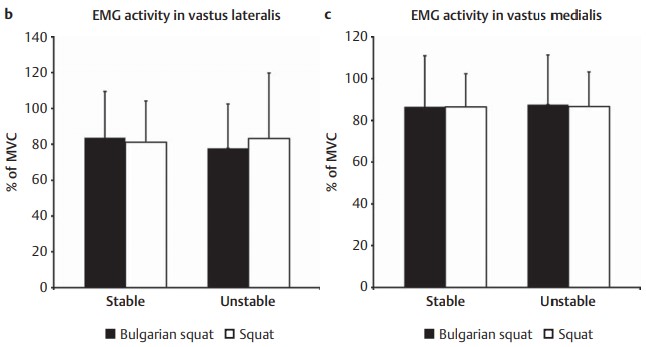
As we can observe in the graph, there are no significant differences between the activation of the vastus lateralis and medialis of the quadriceps during the execution of the classic squat and the Bulgarian squat, both on stable and unstable surfaces.
Activation of the biceps femoris
Below we see the activation of the biceps femoris:

In the Bulgarian squat, there is greater activation of the biceps femoris, whether the exercise is performed on a stable or unstable surface.
According to Mackey and Riemann (2021), in the Bulgarian squat, there is less contribution from the knee joint, which causes the main action (hip extension) to be primarily carried out by the biceps femoris.
During the Bulgarian squat, there is less knee flexion compared to the classic squat, which causes the hamstrings to be major players in this exercise.
In addition to greater activation of the hamstrings, McCurdy et al. (2010) observed in their study that in the Bulgarian squat, there is also greater activation of the gluteus medius and gluteus maximus.
Therefore, the lesser displacement of the knee during the Bulgarian squat makes it a good exercise if we want to focus on hip extension, minimizing the demands on the knee joint.
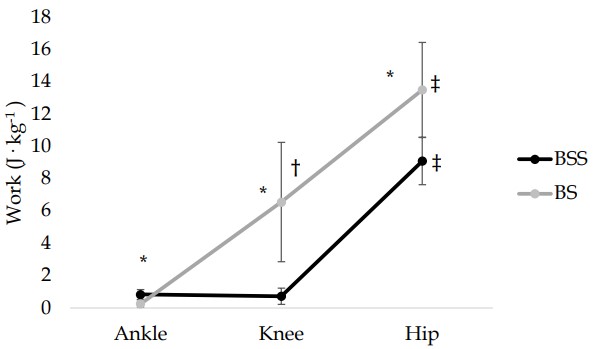
Activation of the soleus
Below we see the activation of the soleus:
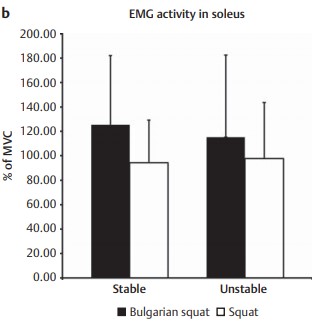
If we focus on the activation of the soleus, it is greater in the Bulgarian squat, both on stable and unstable surfaces. Even so, the differences are not significant in relation to the activation of this muscle.
Activation of the erector spinae
The erector spinae is a group of muscles located in the back that function to extend the spine and stabilize the lumbar area.

As we can see, the erector spinae is more activated in the execution of the classic squat. This is because during the classic squat, there is a greater trunk inclination, and it can also be performed with more load (1).
These two differences compared to the Bulgarian squat require greater stabilization of the lumbar area, hence the greater activation of the erector spinae.
Activation of the core muscles
Below we see the activation of the core muscles in the Bulgarian squat:

In the graph, we see that there are no differences in the activation of the rectus abdominis. However, there are significant differences in relation to the activation of the external oblique.
According to Andersen et al. (2014), there is greater activation of the external oblique in the Bulgarian squat because it is an exercise that requires greater stabilization of the abdominal area (1).
Specifically, the external oblique functions to prevent rotation (anti-rotation) and inclination (anti-inclination) of the trunk.
What can we say about the Bulgarian squat?
After the exhaustive analysis of muscle activation in both exercises, we can conclude that the Bulgarian squat is a hip-dominant exercise.
In fact, the joint participation from greatest to least is: hip, ankle, knee (3).

It is worth noting that performing unilateral exercises is highly advisable in team sports, as actions such as sprinting, jumping, or changing direction are mostly performed unilaterally (3).
Additionally, according to Mackey and Riemann (2021), performing unilateral squats helps to prevent strength imbalances between the two legs.
Mausehund et al. (2019) reported during their study that due to the high co-activation of the hamstrings, the Bulgarian squat is the best unilateral exercise for the early phases of rehabilitation of the anterior cruciate ligament.
Finally, it is interesting to highlight that the inclination of the trunk is one of the most important factors for modifying the activation of the lower body muscles during unilateral exercises.
En este curso vamos a tratar el entrenamiento de la fuerza orientada a la hipertrofia muscular, buscando las formas de optimizar el proceso a la hora de planificar las cargas y las sesiones de entrenamiento.
Aprenderemos a determinar cuándo nos interesa conseguir esa hipertrofia, cómo esta afecta a los niveles de fuerza y la importancia de conocer el estado inicial de la persona que se someta a este tipo de entrenamiento.
Bulgarian squat with emphasis on the glutes
The Bulgarian squat is a perfect exercise to work the lower body, but depending on how you position your body, you will work some muscles more and better than others.
Below we show you the position to achieve greater activation of the glutes.
- Lower with a straight back, but with greater inclination.
- Keep the front knee aligned with the ankle.
- Apply greater hip flexion.
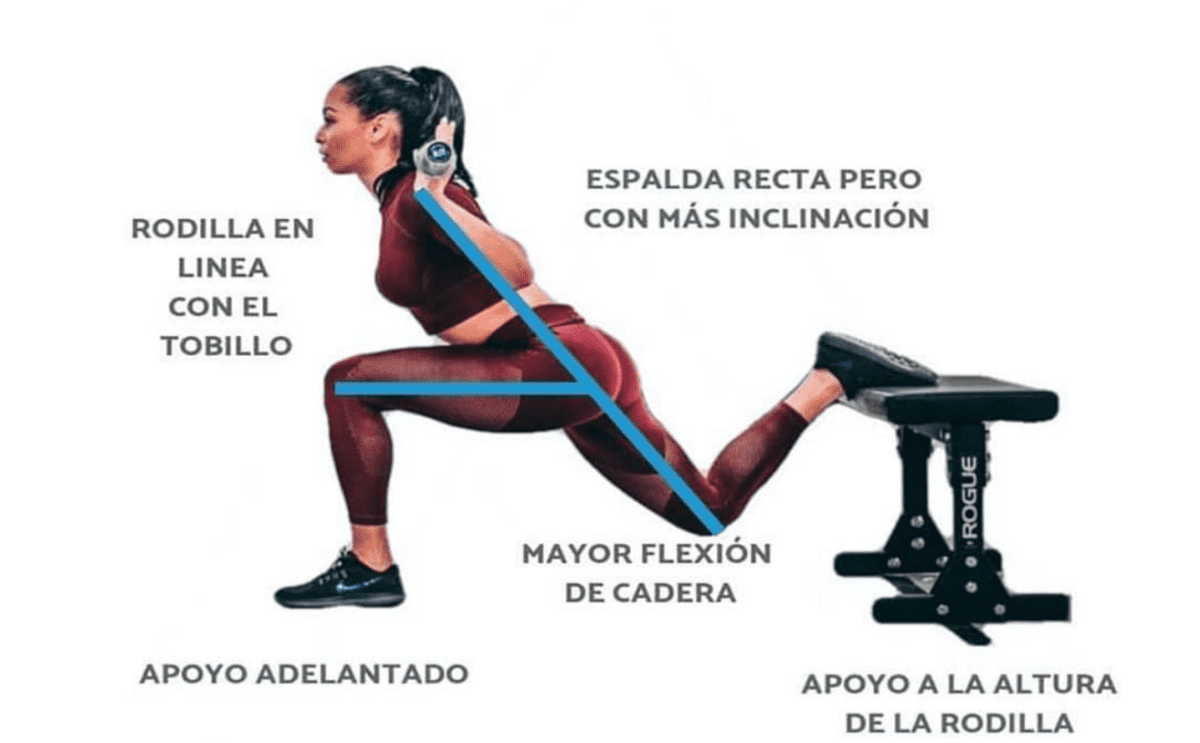
Bulgarian squat with emphasis on the quadriceps
Below we show you the technique of the Bulgarian squat with greater emphasis on the quadriceps:
- The eccentric phase is performed sliding more vertically.
- We keep the back straight and the gaze forward, just like in the Bulgarian squat with emphasis on glutes, but the difference lies in the inclination. If we seek greater emphasis on the quadriceps, we must have less inclination of our trunk.
- Increase the distance between our feet as this will similarly increase the involvement of the quadriceps and reduce that of the glute.
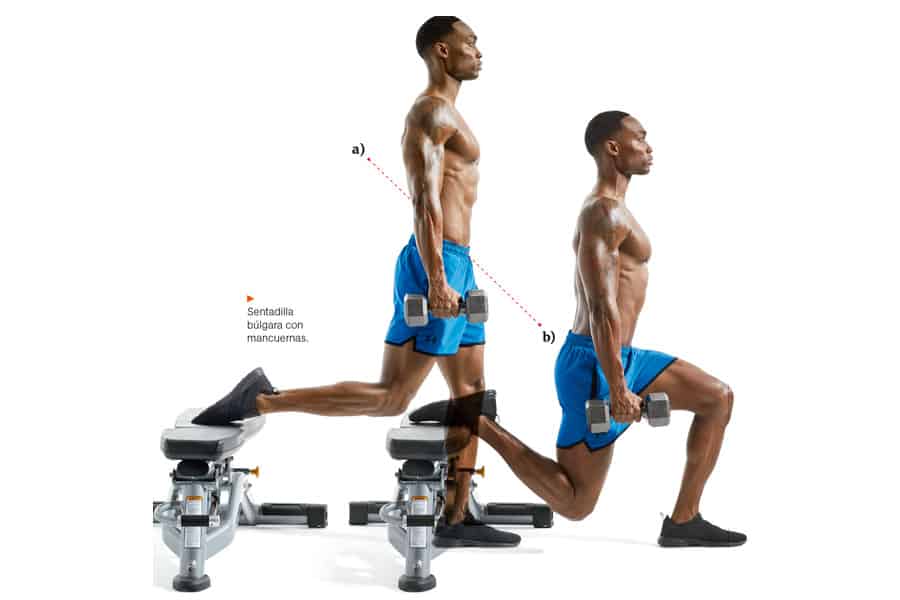
Machine for doing Bulgarian squats
Below we leave you with a very comfortable and efficient machine for working the Bulgarian squat.
Con la máquina de sentadillas de una pierna trabajarás las zonas musculares de los cuádriceps, isquiotibiales y glúteos de forma mucho más efectiva que de la forma tradicional. La sentadilla búlgara supone una dificultad añadida que la máquina de sentadillas soluciona, ya que está específicamente orientada a facilitar todo el proceso del entrenamiento.
Conclusions
After the analysis carried out, we can say that although both the classic squat and the Bulgarian squat are hip-dominant, in the Bulgarian squat there is a greater emphasis on hip extension.
The Bulgarian squat is a very appropriate exercise for team sports because a large part of the actions in these sports are performed unilaterally.
Therefore, if we want to include this exercise in our plan, we must know that we will be prioritizing the work of the hip extensors (hamstrings and gluteus maximus) over that of the hip flexors (rectus femoris).
*Note: If you want to use our fitness calculators, you can visit them on our website where we have many practical ones to use, and all are free. You will calculate your HR, your 1RM in various exercises, and much more.
Podcast “Bulgarian Squat: a theoretical-practical approach”: Play in new window |
Subscribe to Apple Podcasts | Spotify |
Course on Muscle Hypertrophy
If you want to learn more about the Barbell Row and how to get the most out of your workouts, we recommend our Course on Muscle Hypertrophy, based on the latest scientific studies.
Bibliographic references
- Andersen V., Fimland, M., Brennset, O., Haslestad, L., Lundteigen, M., Skalleberg, K. and Saeterbakken, A.. (2014). Muscle activation and strength in Squat and Bulgarian Squat on stable and unstable surface. Int J Sports Med, (35): 1196–1202. http://dx.doi.org/10.1055/s-0034-1382016.
- Mausehund L, Skard AE, Krosshaug T., (2019). Muscle activation in unilateral barbell exercises: Implications for strength training and rehabilitation. J Strength Cond Res 33(Suppl 1): S85-S94, 2019. DOI: 10.1519/JSC.0000000000002617.
- Mackey, E., Riemann, B. (2021). Biomechanical differences between the Bulgarian Split-Squat and Back Squat. International Journal of Exercise Science, 14(1), 533–543. https://www.ncbi.nlm.nih.gov/pmc/articles/PMC8136570/#
- McCurdy K , O’Kelley E , Kutz M , Langford G , Ernest J , Torres M., (2010). Comparison of lower extremity EMG between the 2-leg squat and modified single-leg squat in female athletes. J Sport Rehabil, (19), 57 – 70. DOI: 10.1123/jsr.19.1.57
